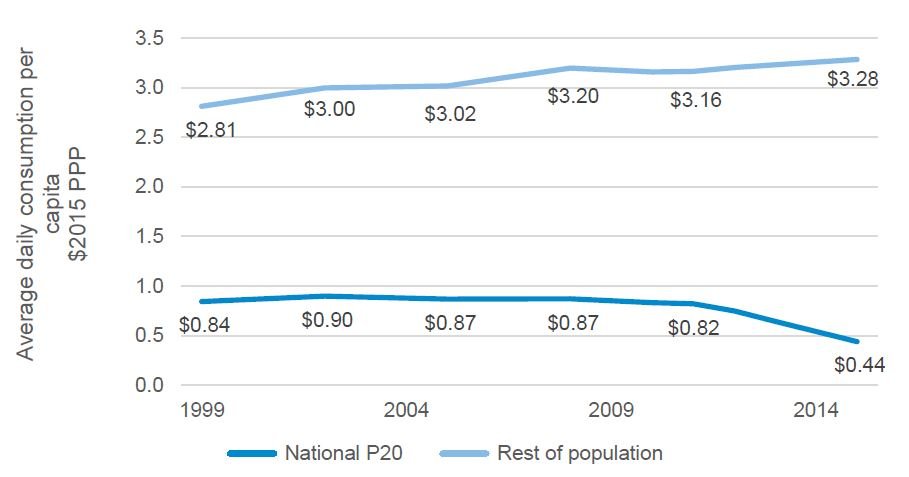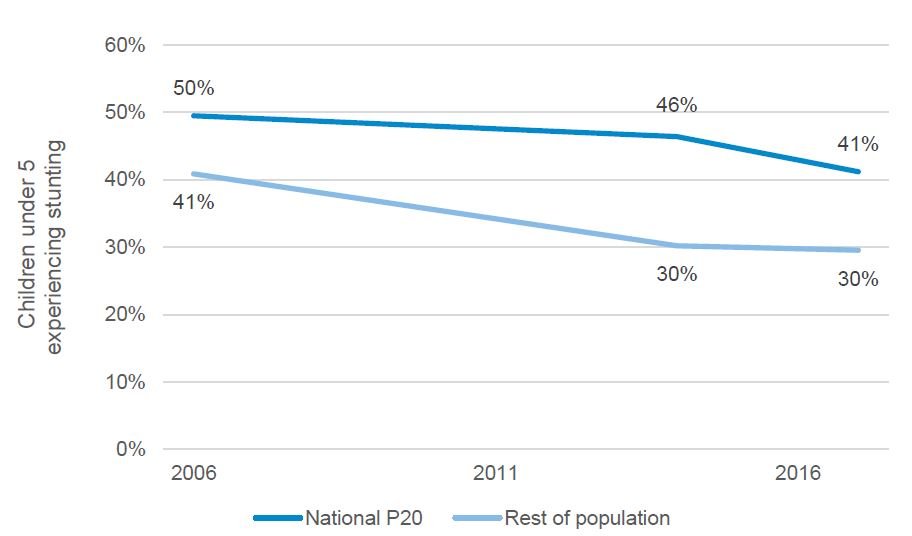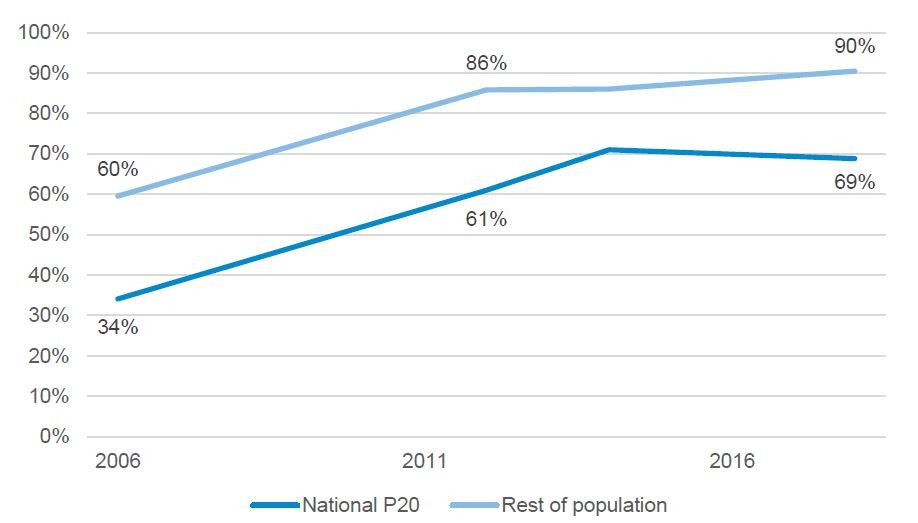The P20 approach is flexible and adaptable. It focuses on a few indicators (in this instance income, nutrition and Civil Registration and Vital Statistics – CRVS) to assess whether the people in the poorest 20% of the population (the P20) are being included in progress or left behind. A detailed methodology is outlined in Appendix 2 and has been used to assess trends among the P20 in Benin.
Income
Trends among the P20 in Benin
The P20 approach shows that despite increasing average household consumption in Benin, people in the bottom quintile – or poorest 20% of people – are being left behind. Under SDG 1, countries have pledged to eliminate poverty in all its forms everywhere. [1] The government of Benin has set itself the goal of reducing the national poverty rate by half among men, women and children of all ages by 2030. In Benin, the average consumption of the poorest 20% of people has decreased from $0.84 per person per day in 1999 to $0.44 in 2015 (the latest year for which data is available). [2] Meanwhile, the rest of the population saw their consumption increase from $2.81 in 1999 to $3.28 in 2015. The trends look even more negative when disaggregated beyond the bottom quintile. The biggest decreases in consumption were seen in the very bottom percentiles among the P20. This means that although the average consumption of the rest of the population remains slightly above the international moderate poverty line of $3.20, conditions have become worse for the poorest 20% of people in Benin.
Figure 1: The growing gap in consumption between the P20 and the rest of the population

Between 1999 and 2015, the average daily consumption per capita in 2015 PPP for the P20 ranged between ninety cents and forty four cents. The highest value was in 2002. In 2011 the value was eighty two cents but the value had dropped to forty four cents by 2015. The sharpest drop was between 2013 and 2015 when the values dropped from sixty four cents to forty four cents. For the rest of the population the average daily consumption was 2.81 dollars in 1999 and it never decreased ending at 3.28 dollars in 2015. The graph shows the widening gap between the P20 and the rest.
Source: Development Initiatives based on World Bank’s PovcalNet 2019
It is not entirely clear why the P20 saw such strong declines in progress between 2011 and 2015. Further research will be needed to explore the distributional effects, but two major economic events coexisted with the declining consumption – global cotton prices decreased, and the economy of Nigeria saw a slowdown – Benin’s largest trading partner.
Recently, the results of a regional study on employment, the informal sector, governance, peace and security were published for Benin. INSAE conducted the Enquête Régionale Intégrée sur l’Emploi et le Secteur Informel (ERI-ESI) with support from the West Africa Economic and Monetary Union (UEMOA) and Observatoire Economique et Statistique d’Afrique Subsaharienne (AFRISTAT). The study concluded that inequality in Benin is growing. It reports that in 2018 the bottom quintile received 1.7% of the wealth generated for the year, while the top quintile received 57%. [3] INSAE is also currently conducting another household survey for poverty mapping. Data collection has not yet begun for the survey and are not expected to be available during 2020.
Operationalising the commitment to leave no one behind
The period 2011–2015 had an average annual GDP growth rate of 5.35%. [4] This strong growth happened at the same time that the P20 saw significant decreases in their consumption, confirming that growth alone is not enough to ensure that no one is left behind. While much of the government’s current strategy documents emphasise economic growth, more needs to be done to ensure that policies also consider ways to make that growth inclusive.
“If we can collect data on the P20, the last quintile, we can know in terms of nutrition, are they being included. In terms of birth registration, are we counting them and putting quality projects in place? In this way, we can address questions of poverty.” Magloire Aguessy, Director General in Charge of SDGs Coordination and Monitoring, Ministry of Planning and Development
The Ministry of Social Affairs and Microfinance plays a major role in addressing the needs of people being left behind. The ministry has specific programmes developed for orphans and vulnerable children, older persons, people with disabilities, women who are victims of violence, vulnerable families and child marriage. Interviewees indicate that the ministry faces significant constraints due to its limited budget. The ministry collects rich data on challenges faced by people at risk of being left behind in Benin; currently it is not digitised, although efforts to do so are in progress.
The government’s highest profile recent initiative to reduce poverty is an ambitious social protection scheme. The Assurance pour le renforcement du capital humain (ARCH) is being implemented throughout the country and aims to provide support to the most vulnerable groups of the population.
Beneficiaries are targeted through the following process:
- Community meetings are held during which community members develop a list of those in their communities believed to be poor.
- RAVIP officials accompany officials who conduct proxy means testing to see if households identified by communities meet the official definitions of poor or extremely poor.
- RAVIP representatives provide digital identity cards and register those households not already recorded by RAVIP.
- ARCH officials conduct community meetings to report the results of the proxy means testing.
- Other groups eligible for ARCH benefits – artisans, older persons, people with disabilities – have their eligibility registered through RAVIP (with the participation of other actors as appropriate).
This process enables the poorest to be targeted without conducting a study of the poverty of every house, reducing cost and time for targeting. It is anticipated that the ARCH programme will be fully launched in 2020; and in three years, the process of identifying eligibility to participate will be repeated. The use of digital identification, the role of community involvement and the participation of multiple ministries provide potential for this approach. Interviewees indicated that there were some concerns about financing the project and accurate classification of participants.
Detailed data on participation in the programme are not publicly available; however, administrative data on this programme would be very useful for tracking the status of the P20, particularly if there are periodic follow up periods on participants.
Nutrition
Trends among the P20 in Benin
Under SDG 2, countries have pledged to end hunger. The government of Benin has set itself the goal of eliminating hunger, all forms of malnutrition (particularly among children, pregnant and nursing women and older persons), and to double the productivity of agricultural producers. Stunting is a key indicator of chronic malnutrition and other deprivations among children under 5 and can have long-term effects on opportunities. Stunting is an indicator of prolonged nutritional deprivation, but it is also linked with low levels of stimulation. It has been linked to physical functions including decreased brain size, complications during pregnancy, labour force productivity and other factors. The World Food Programme (WFP) reports that 9.6% of the population experienced food insecurity as of 2017. [5]
The data indicates that the poorest 20% of people in Benin saw the proportion of children experiencing stunting decrease from 50% to 46% between 2006 and 2014, but improvements were more significant in the rest of the population. Between 2014 and 2017/18, the poorest 20% of people saw stunting rates decrease by 5% from 46% to 41% but, overall between 2006 and 2017/18, the difference between the P20 and the rest increased.
Figure 2: Stunting rates between the P20 and the rest of the population

In 2006, 50 percent of the P20 under age five experienced stunting. This value decreased to 46 percent in 2014 and to 41 percent in 2017/18. For the rest of the population the stunting rate among children under five was 41 percent in 2006, dropping to 30 percent in 2014 and remaining at 30 percent in 2017/18. The graph indicates that at times the P20 have seen faster progress and at times the rest of the population have seen progress but the gap is still significant.
Source: Development Initiatives based on Demographic and Health Surveys, Multiple Indicator Cluster Surveys and World Bank’s PovcalNet
Recently, INSAE launched updated food balance sheets to bring methods up to date with FAO. The report indicated that between 2015 and 2016 the total amount of food calories available per person per day increased by 13%. [6]
Operationalising the commitment to leave no one behind
School canteens, one of the key nutritional programmes in the country, will not have a direct effect on stunting rates as stunting is largely a result of nutritional shortages before children are old enough to begin school.
Civil registration and vital statistics
Trends among the P20 in Benin
The P20 approach indicates that national averages mask recent challenges experienced by the P20 and that the P20 are less likely to be counted.
Under SDG 16, countries have pledged to create inclusive societies for sustainable development, provide access to justice for all and build effective, accountable and inclusive institutions at all levels. The government of Benin has pledged to have all births registered in a civil registration system. This is in line with SDG Target 16.9. Birth registration is a key component of a well-functioning data system and can enhance child protection and access to government services. Despite general progress, birth registration rates decreased slightly from 71% to 69% between the 2014 Multiple Indicators Cluster Survey (MICS) and the 2017/18 Demographic and Health Survey (DHS) for the poorest 20% of children in Benin.
Figure 3: Children under 5 with births registered between the P20 and the rest of the population

In 2006, 34 percent of the P20 under age 5 had their births registered in 2006, increasing to 71 percent in 2014. In 2017/18 the rate for the P20 dropped to 69 percent. For the rest of the population, 60 percent of the population under 5 had their births registered in 2006, rising to 90 percent in 2017/18.
Source: Development Initiative’s calculations based on Multiple Indicator Cluster Survey and Demographic and Health Surveys
Parents are given the 21 days following a birth to register the newborn. After this, they are required to go through a legal process to receive their birth records. Many of the records in Benin are stored on paper, rather than digitised. While digitisation efforts are ongoing in many communes, there are still numerous records that have not been digitised. Consequently, birth registrations may be lost or damaged, and significant resources are devoted to searching ageing books to verify identity documents. This can prevent children from enrolling in school or receiving other government services until the family goes through a legal procedure.
Nationally, birth registration rates slightly improved for children under 5 between the 2014 MICS and the 2017/18 DHS, increasing from 84.8% to 85.5%. In Alibori, the rate increased less than a percentage point, going from 82.6% to 83.4%. In Borgou, there was a significant drop from 75% to 65.4%.
The government’s new national identification campaign, Recensement administratif à vocation d’identification de la population (RAVIP), provides significant potential for ensuring that those in need are counted and their progress is monitored. RAVIP is distinct from CRVS but can be a powerful tool for ensuring that all births and deaths are registered. This is not simply a matter of statistics, identity and civil registration are part of a broader developmental concern touching on many elements.
Operationalising the commitment to leave no one behind
The commune of Kandi has recently devoted a significant share of its resources to fully digitising its CRVS system. All records dating back to the 1950s have been digitised and all new births are digitally reported, with unique ID numbers assigned to each person.
These numbers are distinct from the RAVIP ID numbers. There are still challenges around public awareness, which means births are not fully reported. Marriages, divorces and deaths are rarely reported to the office; however, the digitised system significantly increases the efficiency of the office.
Education
Trends among the P20 in Benin
Human capital accumulation is a key priority for sustainable development. Investments in health and education are important for ensuring that people can translate their labour into sustainable improvements. Human capital is about producing economic growth from the population but requires investments in young people, with long-term potential payoffs in countries with young average populations such as Benin. There are also strong arguments to be made for investments in human capital on moral ground for its potential to enrich the lives of populations regardless of the economic consequences.
There have been recent reversals in education in Benin. Primary gross enrolment rates decreased from 97.5% according to the 2014 MICS to 88.7% according to the 2017/18 DHS. To better understand the context, participants in our workshop were invited to provide insights about education both in Alibori and Borgou and in Cotonou. Several observations emerged. Early marriage and young pregnancies are a significant challenge to keeping girls in school. Teacher retainment was a key challenge in Alibori and Borgou particularly in lower income areas. In Alibori, some civil society members raised questions about radical religious schools opening, but local officials assured that they are taking efforts to ensure that only recognised schools remain open.
In northern schools, civil society members reported that some teachers were assigned to two or three classrooms, not having time to adequately address the educational needs of students. This is diminishing the intellectual level of the children. To compensate for these challenges, there are stories of parents raising personal funds to bring temporary teachers to their schools.
Operationalising the commitment to leave no one behind
From a data systems approach, Benin’s educational sectoral plan published in 2018 sets the goal of developing a systeme d’informations et de gestion de secteur de l’education (SIGE). [7] Such systems if adequately digitised and used can significantly improve gaps in delivering services in the system and can improve the ability of the country to track progress among students and target challenges.
Health
Trends among the P20 in Benin
Several key challenges were raised in discussions on health. Two major challenges mentioned in Borgou and Alibori were reduced access by rural populations to emergency and routine care. This was a result of inadequate means of transportation between hospitals and rural areas impeded by an inadequate number of ambulances, poor road conditions, and the closing of some rural health clinics. Additionally, many people said that there is a strong need for additional funds for those unable to afford care.
Operationalising the commitment to leave no one behind
The data systems for administrative data seem strong in Benin. Each department has several sanitary zones. Zone statisticians collect data from health facilities in the private and public sectors and submit them to the central data warehouse where data are validated. Procedures for sharing data with the public are not clearly established, reducing some of the potential usefulness of these systems. Regularly updated data posted in an accessible format on the Ministry of Health’s website and INSAE’s website would increase use.
Cross-cutting issues and the P20
Several cross-cutting issues were raised about the P20 in the course of the technical workshop and high-level roundtable in Cotonou. There are other sectors that merit further exploration of policies and the data to identify key needs for the P20. While some general insights are provided from these meetings, it is worth mentioning that the experiences of people in the P20 in Benin are likely to be different from the rest of the population with respect to infrastructure, water, sanitation, electrification, agriculture, entrepreneurship, internet access, security, governance, environmental degradation, among others. Future studies are needed to apply the P20 approach with greater depth to identify key issues in other sectors.
Notes
-
1
Globally the poorest 20% of the population has seen its average daily consumption increase from $1.07 per person per day in 1999 to $1.80 in 2015 (the latest year for which data is available). In absolute terms the rest of the global population saw their average daily consumption grow even more: from $13.71 in 1999 to $18.37 in 2015.Return to source text
-
2
Development Initiatives based on World Bank’s PovcalNet 2020.Return to source text
-
3
Ministère du Plan et du Développement, 2020. Enquête Régionale Integree sur l’Emploi et le Secteur Informel (ERI-ESI) Benin, 2018, page 49, https://www.insae-bj.org/actualites/147-dissemination-de-l-enquete-regionale-integre-sur-l-emploi-et-le-secteur-informel-eri-esif (accessed 28 January 2020).Return to source text
-
4
Development Initiatives calculations based on INSAE National Accounts, www.insae-bj.org/ (accessed 3 February 2020).Return to source text
-
5
World Food Programme, Benin Country profile, www.wfp.org/countries/benin (accessed 3 February 2020).Return to source text